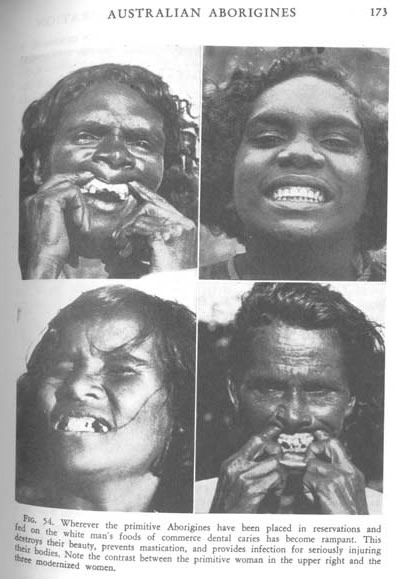

Dr. Weston Price was a dentist who traveled around the world in the 1930’s studying the diet’s of primitive peoples isolated from the modern world who did not consume any modern foods. One of the isolated groups of people Dr. Priced studied was the Australia Aborigines. “Wherever the primitive Aborigines have been placed in reservations and fed on the white man's foods of commerce dental caries has become rampant. This destroys their beauty, prevents mastication, and provides infection for seriously injuring their bodies.” The disparity of the near perfect teeth from the Aborigines eating their natural fair, and the severely decay teeth from Aborigines eating the white man’s food is due largely to a deficiency in nutrients. Dr. Price found that primitive people’s on average enjoyed 4-10 times more nutrients in their foods than what the United States government recommends its citizens to eat. In eating sub-standard foods, a vast majority of the American population is far below the inferior US recommended daily allowance (RDA) for nutrients. Not only did eating “white man’s foods” decay the teeth of indigenous people’s, it also over time made them infertile, made giving birth severely long and painful, created birth defects, and led to many people suffering a wide variety of diseases, which when eating their primitive diet, they where immune to. Dr. Price also noted that “It should be a matter not only of concern but deep alarm that human beings can degenerate physically so rapidly by the use of a certain type of nutrition..”
Caption Page 172: “Note the magnificent dental arches and beautiful teeth of these primitives. Tooth decay was almost unknown in many districts.”

Caption page 173: “Wherever the primitive Aborigines have been placed in reservation and fed on the white man’s foods of commerce dental caries has become rampant… Note the contrast between the primitive woman in the upper right and the three modernized women.”
Source: Weston Price, Nutrition and Physical Degeneration, Page 172, 173
Images used with permission of Price-Pottenger Nutrition Foundation http://www.price-pottenger.org/
Please note, these white man’s foods where the same foods that white people in Australia regularly ate at the time, and so the modernized Aborigines had a similar incidence of tooth decay and other diseases as the white population versus the disease and decay resistant Aborigines on their natural diet.

Left: [Fijians] The development of the facial bones determines the size and shape of the palate and the size of the nasal passages. Note the strength of the neck of the men above and the well-proportioned faces of the girls below. Such faces are usually associated with properly proportioned bodies. Tooth decay is rare in these mouths so long as they use an adequate selection of native foods.

Right: These natives of the Fiji Islands illustrate the effect of changing from the native food to the imported foods of commerce. Tooth decay becomes rampant and with it is lost the ability to properly masticate the food. Growing children and child bearing mothers suffer most severely from dental caries.
Source: Nutrition and Physical Degeneration, Weston Price
Image used with permission of Price-Pottenger Nutrition Foundation http://www.price-pottenger.org/
Nutrient Deficiency
Table 3A.--Nutrient intakes: Percentages of individuals with diets below selected levels of the (RDAs), by sex and age, 2-day average [intakes], 1994-96
| Vitamin A | Below 50% RDA | Below 75% RDA | Below 100% RDA |
| Women Ages 20-29 | 31.7% | 52.8% | 68.4% |
| Women Ages 30-39 | 30.5% | 48.4% | 61.0% |
| Vitamin E | Below 50% RDA | Below 75% RDA | Below 100% RDA |
| Women Ages 20-29 | 24.2% | 53.6% | 73.8% |
| Women Ages 30-39 | 21.6% | 49.9% | 71.1% |
What this means is for example that on average, 73.8% of Women ages 20-29 are below meeting the level of the US RDA requirements for health. 24.2% of all Women in the US ages 20-29 do not eat meet half of the US RDA requirements for minimum nutrition related to vitamin E.
Table 3B.--
Percentage of Women who begin to near the level of Nutrients of Indigenous Peoples (In other words, the amount of nutrients our bodies really need)
Vitamin A Above 200% RDA
Women Ages 20-29 - 10.5%
Women Ages 30-39 - 11.5%
Vitamin E Above 200% RDA
Women Ages 20-29 - 3.9%
Women Ages 30-39 - 3.0%
Source: Supplementary Data Tables, USDA, 1994-1996 http://www.barc.usda.gov/bhnrc/foodsurvey/home.htm
What this means is that only 3.9% of all Women in the US eat more than twice what the US RDA recommends for health for vitamin E. In other words, only 3.9% of Women are possibly close to eating the same level of Vitamin E that Dr. Price found Indigenous peoples ate, the amount of vitamin E required for health.
Modern Foods Lead to Decay and Disease
Healthy Pregnancy Diet Overview Guildlines
From the author of YourReturn.Org
Published Books
Cure Tooth Decay teaches you how to heal and prevent cavities with organic foods.
· Save money on dental bills
· Five tooth decay healing protocols
· Effectiveness rate as high as 95%

A stunning picture of Jesus Face